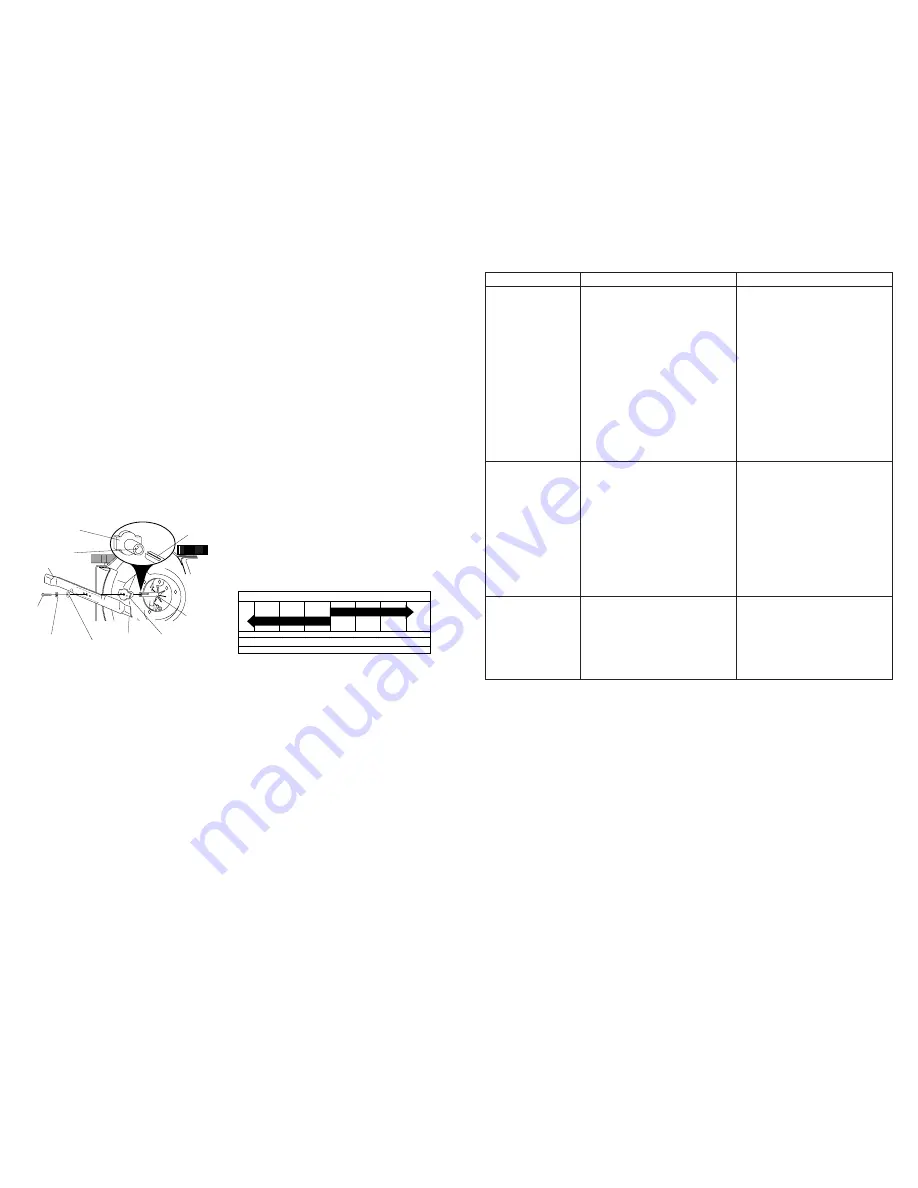
12
Blade
adapter
Blade
bolt
Crank
shaft
keyway
Hardened
washer
Lock
washer
Blade
adapter
Key
Blade
Trailing
edge
Crank
shaft
TEMPERATURE RANGE ANTICIPATED BEFORE NEXT OIL CHANGE
SAE VISCOSITY GRADES
-20°
0°
30°
40°
80°
100°
-30°
-20°
0°
20°
30°
40°
°
F
°
C
32°
-10°
10°
60°
5W-30
SAE 30
IMPORTANT: Blade bolt is grade 8 heat
treated.
TO SHARPEN BLADE
NOTE: We do not recommend sharpen-
ing blade - but if you do, be sure the blade
is balanced.
Care should be taken to keep the blade
balanced. An unbalanced blade will
cause eventual damage to lawn mower or
engine.
• The blade can be sharpened with a file
or on a grinding wheel. Do not attempt
to sharpen while on the mower.
• To check blade balance, drive a nail
into a beam or wall. Leave about one
inch of the straight nail exposed. Place
center hole of blade over the head of
the nail. If blade is balanced, it should
remain in a horizontal position. If either
end of the blade moves downward,
sharpen the heavy end until the blade
is balanced.
GRASS CATCHER
• The grass catcher may be hosed with
water, but must be dry when used.
• Check your grass catcher often for
damage or deterioration. Through normal
use it will wear. If catcher needs replacing,
replace only with a manufacturer approved
replacement catcher. Give the lawn
mower model number when ordering.
ENGINE
LUBRICATION
Use only high quality detergent oil rated
with API service classification SF, SG or
SH. Select the oil's SAE viscosity grade
according to your expected operating
temperature.
NOTE: Although multi-viscosity oils
(5W30, 10W30 etc.) improve starting in
cold weather, these multi-viscosity oils
will result in increased oil consumption
when used above 32°F. Check your
engine oil level more frequently to avoid
possible engine damage from running
low on oil.
Change the oil after every 25 hours of
operation or at least once a year if the
lawn mower is not used for 25 hours in
one year.
Check the crankcase oil level before
starting the engine and after each five (5)
hours of continuous use. Tighten oil plug
securely each time you check the oil
level.
DRIVE WHEELS
Check front drive wheels each time
before you mow to be sure they move
freely.
The wheels not turning freely means
trash, grass cuttings, etc. are in the drive
wheel area and must be cleaned to free
drive wheels.
If necessary to clean the drive wheels,
check both front wheels.
• Remove hubcaps, hairpin cotters and
washers.
• Remove wheels from wheel adjusters.
GEAR CASE
• To keep your drive system working
properly, the gear case and area
around the drive should be kept clean
and free of trash build-up. Clean under
the drive cover twice a season.
• The gear case is filled with lubricant to
the proper level at the factory. The only
time the lubricant needs attention is if
service has been performed on the
gear case.
• If lubricant is required, use only Texaco
Starplex Premium 1 Grease, Part No.
750369. Do not substitute.
• Remove any trash or grass cuttings
from inside the dust cover, pinion and/
or drive wheel gear teeth.
• Put wheels back in place.
• If after cleaning, the drive wheels do
not turn freely, contact your nearest
authorized service center.
17
Does not start
1. Dirty air filter.
1. Clean/replace air filter.
2. Out of fuel.
2. Fill fuel tank.
3. Stale fuel.
3. Drain tank and refill with
fresh clean fuel.
4. Water in fuel.
4. Drain fuel tank and
carburetor and refill tank
with fresh gasoline.
5. Spark plug wire is
5. Connect wire to plug.
disconnected.
6. Bad spark plug.
6. Replace spark plug.
7. Loose blade or broken blade 7. Tighten blade bolt or
adapter.
replace blade adapter.
8. Control bar in released
8. Depress control bar to
position.
handle.
9. Control bar defective.
9. Replace control bar.
Loss of power
1. Rear of lawn mower housing 1. Set to “Higher Cut”
or cutting blade dragging
position.
in heavy grass.
2. Cutting too much grass.
2. Set to “Higher Cut”
position.
3. Dirty air filter.
3. Clean/replace air filter.
4. Buildup of grass, leaves,
4. Clean underside of mower
and trash under mower.
housing.
5. Too much oil in engine.
5. Check oil level.
6. Walking speed too fast.
6. Cut at slower walking
speed.
Poor cut – uneven 1. Worn, bent or loose blade.
1. Replace blade. Tighten
blade bolt.
2. Wheel heights uneven.
2. Set all wheels at same
height
3. Buildup of grass, leaves
3. Clean underside of
and trash under mower.
mower housing.
PROBLEM
CAUSE
CORRECTION
TROUBLESHOOTING CHART
































